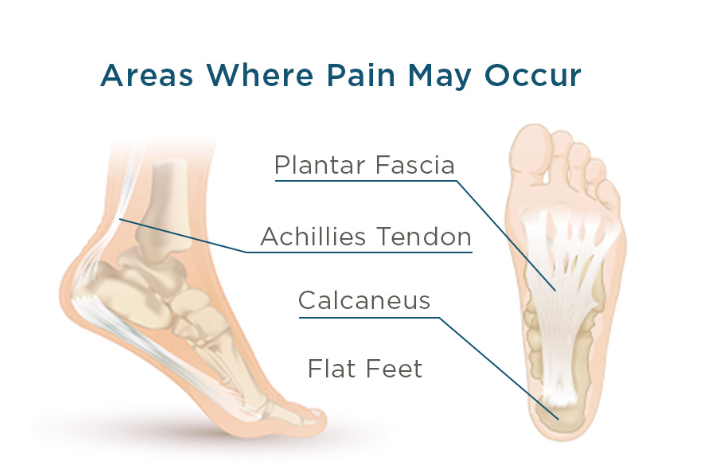Flat feet may appear innocent, but will be more painful than most folks ever realized. If the natural foot arch collapses or never formed, your whole body posture is affected. The result: foot, knee, hip, even lower back pain. The best news: you can avoid pain, enhance balance, and walk a lot easier every day with proper foot arch support for flat feet.
Understanding Flat Feet
Flat feet or dropped arches mean that your arches sag so that the soles of the feet come in contact with the ground completely. Either it is a birth defect or one gets it through age, injury, obesity, or a weak muscle.
With flat feet, there is no structure in the body that aids to act as a shock absorber and balance. This will have the tendency of causing overpronation, where your feet roll inwards during walking. With time, this will become:
- Heel or arch pain
- Swelling of ankles and feet
- Malalignment of the knee or hip
- Fatigue on standing or walking
It is because of this that proper flat foot arch support is so crucial. It will restore stability, good posture, and keep pain from shooting throughout your entire body.
Why Arch Support Matters
Your arches have a very significant function in shock absorption and movement. Your arches bear your weight and help to redistribute pressure evenly on your feet. If your arches collapse, pressure cannot be evenly distributed and your joints, muscles, and ligaments become stretched too far.
Flat foot arch support is advantageous in many ways:
- Better alignment: Getting your legs and feet where they need to be in order to stabilize your spine.
- Reduces pain: Eliminates stress on your heels, plantar fascia, and knees.
- Stability: Prevents rolling in of your feet.
- Comfort: Eliminates walking or standing for hours from being an issue.
- Prevents injury: Prevents conditions such as plantar fasciitis or tendonitis from forming.
Arch support is not only wonderful for your feet—your whole body’s mobility and standing are stabilized.
Types of Foot Arch Support
Not all arch supports are the same. Yours will be based on your foot, activity level, and tolerance for comfort. The following are the primary ones to consider:
Over-the-Counter Insoles
Prefabricated inserts which are readily available everywhere and suitable for mild to moderate support. If you have only a slight bit of discomfort or want to provide overall foot comfort, these are suitable. Utilize insoles which are “stability” or “motion control” labeled to provide gains.
Custom Orthotics
Orthotics are tailored to your feet by a podiatrist. They are constructed from a 3D mold or impression of your foot for a fit that is tailored to perfection. Custom arch support for flat feet offers accurate alignment and long-term comfort—especially if you have chronic pain or joint problems.
Supportive Footwear
Most contemporary businesses produce arch-supportive flat shoes for flat feet. They possess rigid midsoles, large heel beds, and cushioned insoles to provide support and reduce fatigue. Supportive walking shoes on a daily basis can bring a dramatic change in posture and comfort.
Arch Support Sandals and House Shoes
Even at home, it makes a difference. Barefoot walking on hard surfaces aggravates pain in the feet. Do the opposite and walk in sandals or slippers with contoured footbeds that support the arches and allow your feet to rest as nature meant your feet to rest.
Key Features to Look For
When purchasing foot arch support for flat feet, ensure to look for the following key features:
- Firm but giving support: Provides lift without stiffness.
- Deep heel cup: Wraps around heel and limits movement.
- Shock-absorbing cushioned midsole: Envelops and massages your feet.
- Breathable fabrics: Draws moisture away from your feet, drying and cooling them.
- Long-lasting construction: Will not become deformed after a few months’ use.
Where possible, test shoes or insoles initially. Supportive arches should be comfortable right away—no pinching, too tight.
How to Break into New Arch Supports
When wearing arch supports for the first time, let your feet acclimatize. The altered alignment may feel new at first, but your ligaments and muscles will adapt very quickly.
- Begin gradually: Wear your new supports for one to two hours each day.
- Increase gradually: Gradually add time each day as your comfort increases.
- Stretch every day: Gentle calf and arch stretches will ease tightness.
- Replace flat shoes: Flat shoes can spoil the advantage of new supports.
Within a week or two, you will be stable and comfortable while walking or standing.
Exercises to Strengthen Flat Feet
Apart from wearing foot arch support for flat feet, there are some exercises which can make muscles supporting your arches strong and flexible. Try following simple movements:
- Towel scrunches: Scrunch a towel towards you with your toes while sitting.
- Heel raises: Stand on the balls of your toes and hold for a few seconds, then lower your heels slowly.
- Rolling massage: Roll a cold water bottle or tennis ball along the back of your foot for one minute.
- Arch lifts: Stand and push down on your toes and lift your arches slowly.
Do these exercises a few times to stabilize the foot and strengthen weak muscles.
Lifestyle Tips for Adapting to Flat Feet
Arch support is just half of a long comfort regimen. Including good foot-care habits can double the good and erase pain.
- Maintain a healthy weight: Avoids unnecessary stress on your arches and joints.
- Wear daily support shoes: Avoid flat shoes or sandals.
- Rest as needed: Prop your feet after walking or standing for long periods.
- Replace worn-out supports: Replace inserts every 6–12 months.
- Be active: Low-impact activities such as walking or swimming keeps the foot flexed and strengthened.
With these practices, and with proper support of the arch of the foot in flat feet, long-term mobility and comfort are optimized.
When to See a Podiatrist
If your pain continues despite your having been fitted with support shoes and insoles, you need to see a podiatrist. Chronic pain is one symptom of a serious condition such as posterior tibial tendon dysfunction or plantar fasciitis.
A podiatrist can assess your walk, measure the flatness of your feet, and give you orthotics or physical therapy. Early treatment avoids subsequent trouble and gets you walking and pain-free.
Conclusion
Your feet are the cornerstone of your body frame, and without the aid of what it requires, every step is stressful. The correct arch support for the feet for flat feet will be that feeling of a new world—to move about in a normal way, stand straight, and be free from pain.
Whatever you do want to spend money on over-the-counter inserts, custom orthotics to have made especially for you, or support shoes, an excellent arch support is an investment in your way of life. Add this to strengthening exercises, healthy ways of living, and low-maintenance care and you’ll be walking a whole new world of difference within a very short space of time.
With your arch nicely supported by cushioned arch support, you can walk with ease, go about your activities without difficulty, and take each step confidently and without any hassle.



